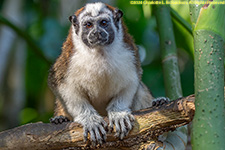 Central American agouti, Dasyprocta punctata
Central American agouti, Dasyprocta punctata
Parque Nacional Soberania is only 27km from Panama City, making it a very-accessible tropical rainforest. It extends from Limon on on Lago Gatun to just north of Paraiso and hosts 125 known mammal species, 402 bird species, 55 amphibian species, 79 reptile species, and 34 fresh-water fish species. The 17km-long dirt Pipeline Road (Camino del Oleoducto or Sendero Oleoducto) is famous for its birdlife, with more than four hundred species spotted from the trail. The road was built by the USA during WWII to service an oil pipeline that was built but never used during the war.
The Panama Rainforest Discovery Center has a 32m (172 steps) observation tower made of recycled material from the canal that is great for early-morning bird spotting, some hiking trails, and feeding stations for some fifteen species of hummingbirds.
We based ourselves at the Gamboa Rainforest Resort.
Wildlife:
Mammals:
Agoutis are small rodents native to Central America. They are related to guinea pigs, capybaras, and pacas.
 Central American agouti, Dasyprocta punctata
Central American agouti, Dasyprocta punctata
Coatimundis (coatis) are omnivorous diurnal mammals native to South and Central America, Mexico, and the southwestern United States. They are related to raccoons.


 White-nosed coati, Nasua narica
White-nosed coati, Nasua narica
White-tailed deer are a medium-sized deer native to North, Central and South America. The Central American animals are smaller and less conspicuous than the northern ones and have much smaller antlers.
 White-tailed deer, Odocoileus virginianus
White-tailed deer, Odocoileus virginianus
Sloths, Neotropical animals related to anteeaters, are noted for their slowness of movement, spending most of their lives hanging upside-down from rainforest trees. All sloths have three toes on their rear limbs.
 Hoffmann's two-toed sloth, Choloepus hoffmanni
Hoffmann's two-toed sloth, Choloepus hoffmanni


 Brown-throated three-toed sloth, Bradypus variegatus. The striped color pattern on its back shows this one is a male.
Brown-throated three-toed sloth, Bradypus variegatus. The striped color pattern on its back shows this one is a male.
Monkeys:
Capuchin monkeys occupy the wet lowland forests on the Caribbean coast of Panama and the deciduous dry forest on the Pacific coast.

 Panamanian white-faced capuchin, Cebus imitator
Panamanian white-faced capuchin, Cebus imitator
Howler monkeys are the most widespread primate genus in the Neotropics, native to South and Central American forests. They are famous for their loud howls, which can be heard up to three miles away even through dense rainforest. There are fifteen species. They eat fruit and leaves.



 Mantled howler, Alouatta palliata
Mantled howler, Alouatta palliata
Tamarin monkeys are omnivorous squirrel-sized New World monkeys. There are twenty-two species. The tiny Geoffroy's tamarin is the only Central American species.





 Geoffroy's tamarin (Panamnian, red-crested, or rufous-naped tamarin, mono titi), Saguinus geoffroyi
Geoffroy's tamarin (Panamnian, red-crested, or rufous-naped tamarin, mono titi), Saguinus geoffroyi
Reptiles:
The Meso-American slider turtle is found from Mexico to Columbia.
 Meso-American slider, Trachemys venusta uhrigi
Meso-American slider, Trachemys venusta uhrigi
Caimans are related to alligators. They are found in Mexico and Central and South America.

 Spectacled caiman, Caiman crocodilus
Spectacled caiman, Caiman crocodilus
American crocodiles are a crocodilian species found in the Neotropics. They can tolerate salt water. It is the largest reptile in Central America.
 American crocodile, Crocodylus acutus
American crocodile, Crocodylus acutus
Snakes: the fer-de-lance is a highly poisonous pit viper. They are fast-moving and readily bite if annoyed.
 Fer-de-lance (terciopelo), Bothrops asper
Fer-de-lance (terciopelo), Bothrops asper
Iguanas: The green (American or common green) iguana is a large arboreal lizard with a row of spines along its back.
Basilisks are endemic to southern Mexico, Centra America, and northern South America. There are four species.

 Striped (brown) basilisk, Basiliscus vittatus
Striped (brown) basilisk, Basiliscus vittatus
Insects:
Ants:
 Leafcutter ants (one of 47 species in two genera)
Leafcutter ants (one of 47 species in two genera)
Dragonflies:
Butterflies:

 Tropical buckeye, Junonia evarete
Tropical buckeye, Junonia evarete
 White peacock, Anartia jatrophae
White peacock, Anartia jatrophae
Birds:
©2024 Mermaid Underwater Photographic. All Rights Reserved.
Contact us at mermaid@underwater.org.
Last modified 9 March 2024